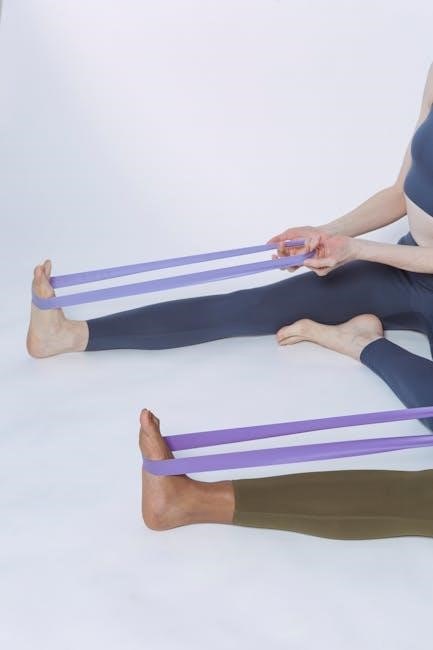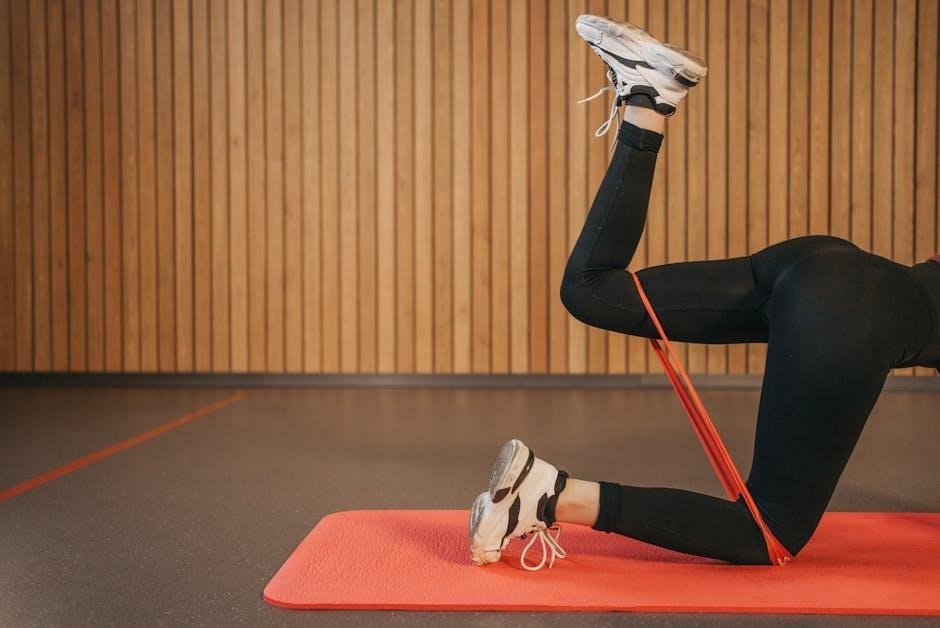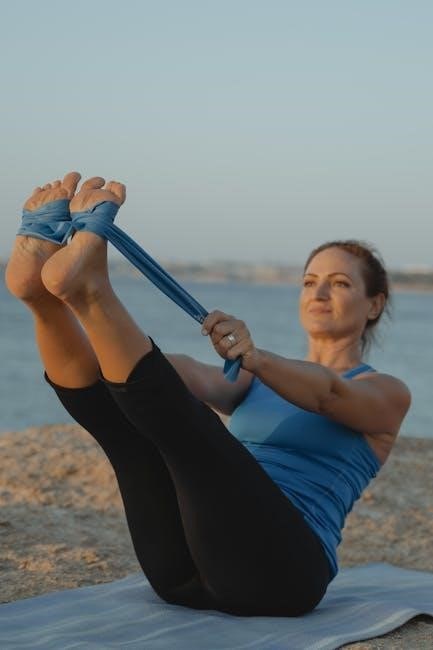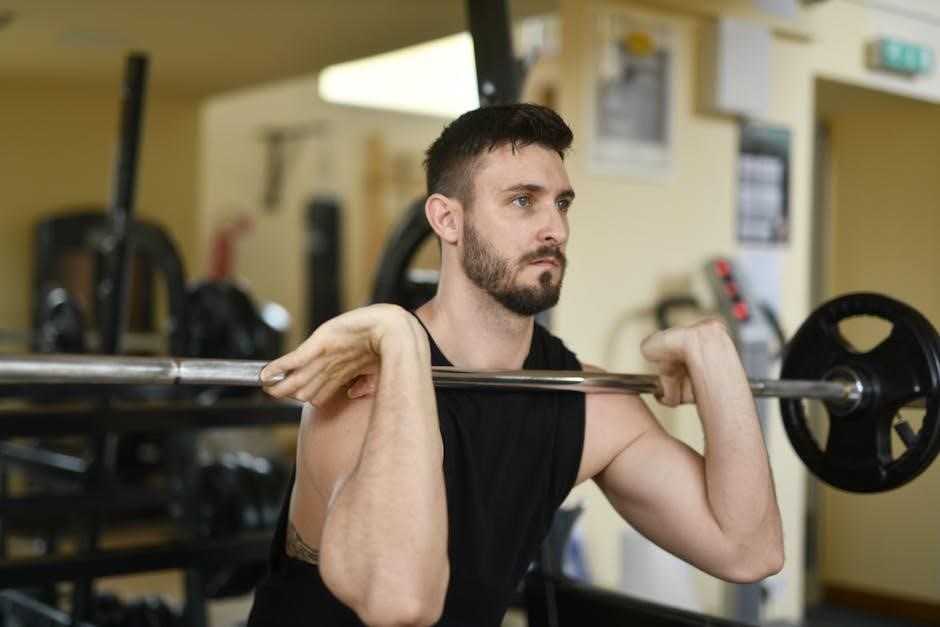Resistance band shoulder exercises offer a versatile, portable, and cost-effective way to strengthen and rehabilitate shoulder muscles. Perfect for home workouts, they target deltoids, rotator cuffs, and trapezius muscles effectively, improving posture and overall shoulder stability. With adjustable resistance levels, these exercises cater to all fitness levels, making them ideal for both rehabilitation and strength training. Their convenience and effectiveness make them a popular choice for those seeking efficient shoulder workouts at home or on the go.
1.1 What Are Resistance Bands?
Resistance bands are lightweight, portable, and affordable fitness tools designed to provide tension for strength training. They come in various forms, including looped bands, resistance tubes with handles, and fabric-covered bands. These bands offer adjustable resistance levels, making them suitable for both rehabilitation and muscle-building exercises. Their versatility allows users to target specific muscle groups, such as the shoulders, while improving flexibility and mobility. Resistance bands are ideal for home workouts, travel, or gym sessions, offering a cost-effective alternative to traditional weights. Their simplicity and effectiveness make them a popular choice for individuals seeking efficient shoulder exercises.
1.2 Benefits of Using Resistance Bands for Shoulder Training
Resistance bands are a highly effective tool for shoulder training, offering numerous benefits. They are lightweight, portable, and cost-effective, making them ideal for home workouts or travel. Bands provide adjustable resistance levels, catering to all fitness levels, from rehabilitation to advanced strength training. They allow for targeted exercises that strengthen the deltoids, rotator cuffs, and trapezius muscles, improving posture and overall shoulder stability. Additionally, resistance bands enable smooth, controlled movements, reducing the risk of injury compared to heavy weights. Their versatility and ease of use make them a practical choice for individuals seeking to enhance shoulder strength and mobility without bulky equipment.
1.3 How to Choose the Right Resistance Band
Selecting the right resistance band is crucial for effective shoulder training. Bands vary in resistance levels, materials, and designs, such as pull-up bands, mini loops, or fabric-covered bands. Lighter resistance bands are ideal for rehabilitation or beginners, while heavier bands suit advanced strength training. Consider your fitness level and goals when choosing. Fabric-covered bands are durable and prevent rolling during exercises. Portability and versatility make resistance bands a practical choice for home or travel workouts. Start with lighter resistance and progress as strength improves for optimal results and safety.

Essential Shoulder Exercises Using Resistance Bands
Master fundamental exercises like shoulder presses, lateral raises, and rotations to build strength, flexibility, and proper posture. These workouts target all shoulder muscles effectively for a balanced physique.
2.1 Standing Shoulder Press
Begin by standing tall with your feet shoulder-width apart, holding a resistance band at shoulder height with both hands. Engage your core and press the band straight overhead until your arms are fully extended. Focus on squeezing your shoulder muscles at the top of the movement, then slowly lower the band back to the starting position. This exercise targets the deltoids and triceps, improving overhead strength and stability. Maintain controlled movements to avoid injury and maximize muscle engagement. For added challenge, increase resistance or incorporate slight leg movements to enhance stability during the press.
2.2 Seated Shoulder Press
Sit on a stable chair or bench with your feet flat on the floor, holding a resistance band at shoulder height with both hands. Grip the band with palms facing forward, ensuring it is taut at the starting position. Press the band straight overhead, extending your arms fully while engaging your core for stability. Slowly lower the band back to shoulder height, maintaining control throughout the movement. This exercise effectively targets the deltoids and triceps, enhancing overhead pressing strength. To increase difficulty, use a thicker band or perform the press with one arm at a time, alternating sides with each rep.

2.3 Lateral Raises
Stand on the resistance band with your feet shoulder-width apart, holding the ends at shoulder height with palms facing your thighs. Engage your core and lift the band out to the sides until your arms are parallel to the floor, maintaining a slight bend in your elbows. Avoid shrugging your shoulders; focus on squeezing your lateral deltoids. Slowly lower the band back to the starting position, controlling the movement throughout. This exercise targets the lateral deltoids, improving shoulder width and overall deltoid development. For added challenge, increase the resistance level or perform the exercise with a slower tempo, emphasizing muscle engagement.
2.4 Front Raises
Hold the resistance band in both hands at shoulder height, palms facing forward. Stand with your feet shoulder-width apart on the band. Lift your arms straight forward, keeping them parallel, until they reach shoulder height. Focus on engaging your front deltoids and avoid swinging. Hold briefly, then slowly lower your arms back to the starting position, maintaining control. This exercise targets the anterior deltoids, enhancing shoulder strength and stability. To increase difficulty, use a higher resistance band or perform the movement with a brief isometric hold at the top of the raise, intensifying muscle activation and endurance.
2.5 Rear Delt Fly
Anchor the resistance band at waist height or hold it in both hands while standing sideways. Bend slightly at the knees and hinge forward at the hips. With your arms straight, pull the band apart, lifting your arms backward until they are in line with your body. Focus on squeezing your rear deltoids and avoid using momentum. Slowly return to the starting position, maintaining control throughout the movement. This exercise effectively targets the posterior deltoids, improving shoulder stability and posture. It also enhances overall shoulder development when combined with other resistance band exercises, making it a key component of a well-rounded shoulder workout routine.
2.6 Shoulder External Rotation
Anchor the resistance band at shoulder height and stand sideways to the anchor point. Hold the band with your elbow bent at 90 degrees, keeping your forearm parallel to the floor. Rotate your arm outward, pulling the band apart until your forearm is parallel to the floor on the opposite side. Avoid using momentum and focus on controlled movement. Hold briefly, then slowly return to the starting position. This exercise strengthens the rotator cuff muscles, particularly the infraspinatus and teres minor, improving shoulder stability and reducing injury risk. Maintain proper form to maximize effectiveness and prevent strain.
2.7 Shoulder Internal Rotation
Anchor the resistance band at shoulder height and stand facing the anchor point. Hold the band with your elbow bent at 90 degrees, keeping your forearm parallel to the floor. Rotate your arm inward, pulling the band toward your abdomen until your forearm is parallel to the floor on the same side. Focus on controlled movement and avoid using momentum. Hold briefly, then slowly return to the starting position. This exercise targets the subscapularis muscle, enhancing internal rotation strength and improving shoulder mobility. Proper form ensures effective targeting of the rotator cuff muscles, supporting overall shoulder health and stability.
2.8 Upright Rows
Stand on the resistance band with your feet shoulder-width apart, holding both ends of the band in each hand. Pull the band upward toward your chin, keeping your elbows high and your back straight. Avoid shrugging your shoulders; focus on using your shoulder and upper back muscles to drive the movement. Slowly lower the band back to the starting position, maintaining control throughout the exercise. Upright rows target the deltoids, trapezius, and rhomboid muscles, helping to improve posture and overall shoulder strength. This exercise is excellent for building a balanced and robust upper body, especially when combined with other shoulder movements.

2.9 Banded Shoulder Shrugs
Stand on the resistance band with your feet shoulder-width apart, holding both ends of the band in each hand at hip level. Engage your core and maintain a neutral spine. Shrug your shoulders upward, squeezing your shoulder blades together without bending your elbows. Hold for a brief moment, then slowly lower your shoulders back to the starting position. Banded shoulder shrugs effectively target the trapezius muscles, improving posture and overall shoulder stability. This exercise is ideal for building strength and can be incorporated into both rehabilitation and strength-training routines for well-rounded shoulder development.

Workout Routines for Shoulder Development
Customize routines based on your goals, whether strength, rehabilitation, or endurance. Mix exercises like shoulder presses, lateral raises, and shrugs for balanced development. Include full workouts or quick sessions for busy schedules, ensuring progression and variation to avoid plateaus and maximize results.
3;1 Full Shoulder Workout Routine
A full shoulder workout using resistance bands targets all major muscle groups, including deltoids, rotator cuffs, and trapezius. Start with standing shoulder presses to engage the front and side deltoids. Follow with lateral raises to isolate the side deltoids, ensuring proper form to avoid strain. Include rear delt flys to strengthen the rear deltoids, which are crucial for posture and overall shoulder stability. Add upright rows to target the trapezius and rhomboids, enhancing shoulder width and posture. Conclude with banded shoulder shrugs to build scapular strength. Perform 3 sets of 12-15 reps for each exercise, resting 60 seconds between sets. This routine promotes balanced shoulder development and improves functional strength. Always warm up before starting and adjust resistance levels as needed to challenge muscles effectively.
3.2 Quick Shoulder Workout for Busy Schedules
A quick shoulder workout with resistance bands is perfect for fitting strength training into a tight schedule. Begin with lateral raises to target the side deltoids, performing 3 sets of 12-15 reps. Follow with front raises to engage the front deltoids, ensuring controlled movements. Incorporate a shoulder press to work multiple muscle groups simultaneously. Finish with rear delt flys to balance posterior shoulder strength. Each exercise should be done in 3 sets of 12-15 reps, with minimal rest between sets. This 15-20 minute routine is efficient, portable, and effective for building shoulder strength and improving posture, even on the busiest days. Adjust resistance levels to suit your fitness level.
3.3 Shoulder Rehabilitation Exercises
Resistance band shoulder rehabilitation exercises are ideal for restoring strength and mobility after injuries or surgery. Begin with gentle shoulder flexion, extending arms forward while maintaining control. Progress to internal and external rotations to target the rotator cuff muscles. Use light resistance to perform controlled movements, ensuring proper form to avoid strain. Incorporate shoulder abduction exercises to improve range of motion. These exercises are low-impact, making them suitable for recovery phases. Perform 3 sets of 10-12 reps for each exercise, gradually increasing resistance as strength improves. Always consult a physical therapist to tailor exercises to specific rehabilitation needs and ensure safe progression.

Progression and Variation in Shoulder Exercises
Progress shoulder workouts by increasing resistance levels or slowing movement tempo. Combine exercises for full engagement and incorporate isometric holds for added intensity and muscle endurance.
4.1 Increasing Resistance Levels
Increase resistance by using thicker bands or layering multiple bands for added tension. Start with lighter bands and progress to heavier ones as strength improves. Adjusting the anchor point, such as raising or lowering it, can also modify resistance levels. For example, anchoring the band higher emphasizes shoulder elevation, while a lower anchor point targets different muscle fibers. Gradually increasing resistance ensures continuous muscle challenge and growth. This progressive overload is key to building stronger, more defined shoulders. Always maintain proper form and control, even as resistance increases, to avoid injury and maximize results.
4.2 Combining Exercises for Full Shoulder Engagement

Combining resistance band exercises targets all shoulder muscle groups, ensuring balanced development. Pair lateral raises with front raises to engage both lateral and anterior deltoids. Incorporate upright rows for trapezius activation and shoulder external rotations for rotator cuff strength. Alternating between pressing and pulling movements, such as shoulder presses followed by rear delt flies, enhances overall shoulder stability. This holistic approach prevents muscle imbalances and promotes functional strength. By mixing exercises, you can address all planes of motion, from frontal to transverse, ensuring comprehensive shoulder engagement and improved posture. This variety keeps workouts dynamic and effective, catering to different fitness goals and levels.
4.3 Incorporating Isometric Holds
Incorporating isometric holds into resistance band shoulder exercises enhances muscle endurance and strength. Hold positions like shoulder presses or lateral raises for 3-5 seconds to engage muscles deeply. This technique improves stabilization and control, particularly beneficial for rehabilitation. For example, holding a banded shoulder press at the top of the movement strengthens the deltoids and trapezius. Isometric holds can also be applied to exercises like external rotations or shrugs, increasing time under tension. Varying hold durations and intensities allows for tailored workouts, making it ideal for both beginners and advanced trainees seeking to enhance shoulder stability and overall performance.

Safety and Form Tips
Ensure proper form to prevent injury. Check bands for damage before use. Start with lighter resistance and gradually increase. Maintain controlled movements and avoid snapping bands. Warm up thoroughly.

5.1 Proper Setup for Shoulder Exercises
Proper setup is crucial for effective and safe shoulder exercises with resistance bands. Stand upright with feet shoulder-width apart, maintaining good posture. Anchor the band at chest or waist height for exercises like presses or rotations. For exercises requiring a door anchor, ensure it is securely fixed to prevent movement. Keep your chest up and engage your core to maintain stability. Use a towel or pad for comfort if the band causes discomfort. Always check the band for any signs of wear or damage before starting. Proper alignment and positioning will help target the correct muscles and prevent injury.
5.2 Avoiding Common Mistakes
When performing resistance band shoulder exercises, it’s essential to avoid common mistakes to prevent injury and maximize effectiveness. Ensure proper form by maintaining controlled movements and avoiding excessive resistance that compromises technique. Keep your core engaged to maintain stability and avoid arching your back. Refrain from using bands that are overly stretched or worn, as they may snap during use. Avoid fully extending your shoulders, as this can strain the joints. Focus on slow, deliberate movements rather than jerky or bouncy actions. Start with lighter resistance and gradually increase as strength improves. Prioritize proper technique to target the correct muscles safely and efficiently.
5.3 Warming Up Before Shoulder Training
A proper warm-up is crucial before starting resistance band shoulder exercises to prevent injuries and enhance performance. Begin with dynamic stretches such as arm circles, shoulder rolls, and side-to-side neck tilts to loosen the muscles. Light cardio, like jumping jacks or jogging in place, can increase blood flow and prepare the shoulders for exercise. Incorporate gentle resistance band movements, such as forward and lateral raises with minimal tension, to activate the deltoids and rotator cuff muscles. Always start with lower resistance and gradually increase as your body warms up. A thorough warm-up ensures better flexibility, reduces stiffness, and minimizes the risk of strain during your workout.

Creating a Printable Resistance Band Shoulder Exercise Guide
A printable guide should include clear images, step-by-step instructions, and exercise organization by difficulty. Add notes sections for tracking progress and staying motivated during workouts.
6.1 Designing a PDF Workout Chart
Design a PDF workout chart with clear visuals and instructions for each exercise. Include exercise names, sets, reps, and tips. Use tables or grids to organize workouts by muscle group or difficulty. Add images or diagrams to demonstrate proper form and ensure the layout is visually appealing. Include space for users to track progress, note modifications, and set goals. Ensure the text is large enough for readability and the design is clean for easy navigation. This will create a user-friendly guide that helps individuals stay motivated and consistent with their resistance band shoulder workouts.
6.2 Including Visual Demonstrations
Incorporate high-quality images or diagrams to visually guide users through each exercise. Show proper starting and ending positions, highlighting key muscle engagements. Use arrows to illustrate movement directions and include close-ups of hand placements and body alignment. For complex exercises like shoulder rotations or presses, provide step-by-step visuals to ensure clarity. Adding before-and-after comparisons can help users understand correct form. Use consistent styling and labeling to maintain a professional look. Visual demonstrations make the exercises easier to follow, reducing the risk of injury and improving workout effectiveness. Ensure images are clear, well-lit, and large enough for easy viewing on all devices.
6.3 Organizing Exercises by Difficulty Level
Arrange exercises in the guide based on difficulty to cater to diverse fitness levels. Begin with basic movements like shoulder shrugs and lateral raises, suitable for beginners. Progress to intermediate exercises such as upright rows and external rotations, which require more strength and control. Advanced exercises, like single-arm presses and dynamic rotations, should be placed at the end. This structure allows users to gradually build strength and confidence. Use clear labels and color coding to differentiate sections. Include brief descriptions of each level to help users identify where to start. This approach ensures the guide is accessible and effective for all fitness stages.
Resistance band shoulder exercises are a versatile and effective way to build strength and improve mobility. For further learning, explore detailed guides and expert recommendations online.
7;1 Summary of Key Points
Resistance band shoulder exercises are a versatile and effective way to build strength, improve mobility, and enhance overall shoulder health. They target key muscles like the deltoids, rotator cuffs, and trapezius, promoting better posture and stability. These exercises are ideal for both rehabilitation and strength training, offering adjustable resistance levels to suit all fitness levels. Their portability and affordability make them a convenient option for home workouts. By incorporating these exercises into your routine, you can achieve stronger, more stable shoulders while reducing the risk of injuries. Consistency and proper form are key to maximizing results and maintaining shoulder longevity.
7.2 Recommended Reading and Further Learning
For deeper insight into shoulder training with resistance bands, explore resources like OrthoInfo and the Shirley Ryan AbilityLab, which offer detailed guides on shoulder rehabilitation and strength exercises. The “ExercisesforFrozenShoulder.pdf” and “Shoulder Exercises w/ Resistance Bands” PDF provide comprehensive routines for recovery and strength. Additionally, books on resistance band training, such as “Resistance Band Training” by James, can expand your knowledge. Websites like Active Health Solutions and OrthoIndy also provide expert-backed exercises and tips. These resources will help you refine your technique, explore new exercises, and achieve a well-rounded shoulder workout routine tailored to your goals and fitness level;
